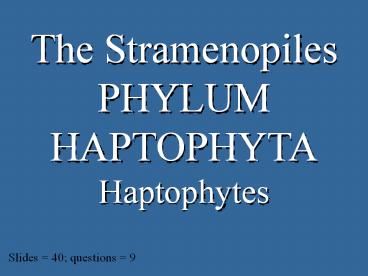Chapter XX Algae PowerPoint PPT Presentation
1 / 30
Title: Chapter XX Algae
1
The Stramenopiles PHYLUM HAPTOPHYTA Haptophytes
Slides 40 questions 9
2
Stramenopiles PHYLUM OOMYCOTA The water molds
3
THE EUKARYOTIC TREE OF LIFE Keeting et al. 2005
Trends in Ecology EvolutionVolume 20, Issue
12, Pages 670-676
4
Some terrestrial oomycetes are important
pathogens
Two genera are of particular importance
Phytophthora (potato blight and sudden oak
death) Pythium (damping off diseases)
5
- POTATO BLIGHT HISTORY
- Irish Catholics under British rule were prevented
from entering professions or purchasing land.
Instead, many rented small 5-acre plots of land
from absentee British Protestant landowners. Half
of all landholdings were less than 5 acres. - Since farmers could grow more potatoes than
grain, most farmers grew potatoes. One acre of
potatoes could feed a family for a year. - About half of Irelands population survived on
potatoes.
6
Potato blight
Potato late blight is one of the most devastating
plant diseases. The epidemics that destroyed
potato crops in Europe in the 1840s led to mass
starvation. In the Great Irish Famine of 1845 to
1847, up to one million people died and a similar
number of people emigrated to the rest of Europe
and the USA.
Potato blight
Potato blight
7
Potato blight
Phytophthora infestans sporangium containing
zoospores
Germinating zoospore
8
Zoospores are released from the sporangium and
germinate. The germ tube penetrates leaf
tissue causing tissue death.
9
Sudden Oak Death
P. ramorum also infects a great number of other
plant species, significantly woody ornamentals
such as Rhododendron, Viburnum, and Pieris
10
CHRYSOPHYTA
The Stramenopiles PHYLUM PHAEOPHYTA brown algae
11
3. DIVISION PHAEOPHYTA
PHAEOPHYTAbrown algae
12
Rhodophyta
- Pigments
- chlorophylls a and c
- chlorophyll c present in few species
- carotenoids
- Photosynthetic reserve Laminarin, mannitol
- Cell Wall composition cellulose, alginic acid
and - sulfated polysaccharides
- Reproductive Mobility Flagella 2, lateral
- Habitat Marine
13
Reproduction is sporic meiosis (alternation of
generations)
Haploid generation
Diploid generation
14
Phaeophyta
Growth forms 1. Filamentous brown algae (these
were not covered in lab or lecture) 2. Kelps and
rock weeds
Macrocystis
15
Phaeophyta
Life cycle is dominated by a large sporophyte
Blades
Air bladder
Stipe
Holdfast
16
Phaeophyta
Kelps and Rockweeds 1. Dominate the shoreline in
cooler climates 2. Sargassum - some species are
free floating and grow into massive mats in the
sargasso sea
17
Phaeophyta - Sargasso
Deep in the Atlantic, strange creatures make
their home among seaweed in a floating lens of
warm, deep-blue water Smithsonian, Sept 1998
18
Phaeophyta - Sargasso
19
Phaeophyta - Sargasso
Many of the animals look more like plants, a sign
that they are a stable and long-lasting community
that has undergone evolutionary adaptation
The nudibranch is difficult to see in this little
clump of sargassum
This crustacean is related to the blue crab
20
Phaeophyta - Sargasso
This shrimps body has a transparent area in the
back and its legs and mouth parts are transparent
- it looks like the bladders on the brown algae
21
Phaeophyta - Sargasso
A yearling loggerhead turtle hides among the
sargassum. The sargassums air bladders keep
the leaves and stems afloat
22
Phaeophyta - Sargasso
This angler fish looks brightly colored away from
the sargassum. It is usually well hidden in the
algae
23
Harvesting Kelp for food in Japan
24
Harvesting Kelp for food in Japan
25
The continuing search for biofuels may include
seaweed
26
2. DIVISION EUGLENOPHYTA
Excavates PHYLUM EUGLENOPHYTAeuglenoids
27
THE EUKARYOTIC TREE OF LIFE Keeting et al. 2005
Trends in Ecology EvolutionVolume 20, Issue
12, Pages 670-676
28
Rhodophyta
- Pigments
- chlorophylls a and b
- chlorophyll c present in few species
- carotenoids
- Photosynthetic reserve Paramylon
- Cell Wall composition Absent
- Reproductive Mobility 1-3, tinsel
- Habitat Marine, fresh water, airborn
29
Flexible protein pellicle with overlapping
strips--euglenoid movement. Both photosynthetic
and non-photosynthetic forms
30
END
END

